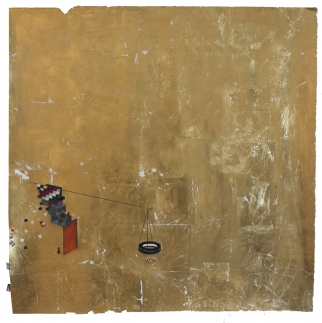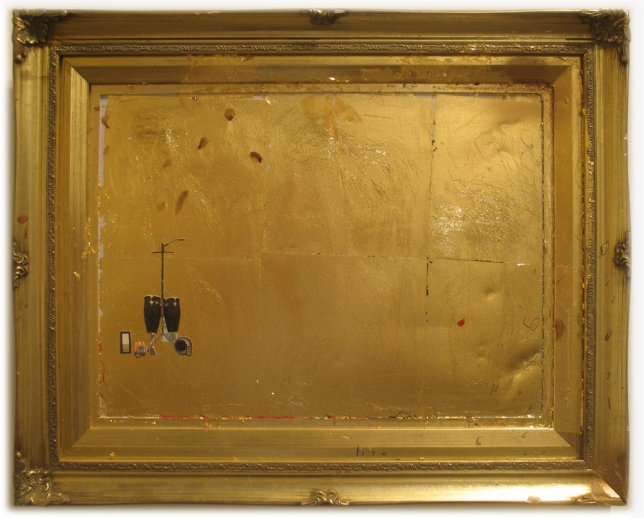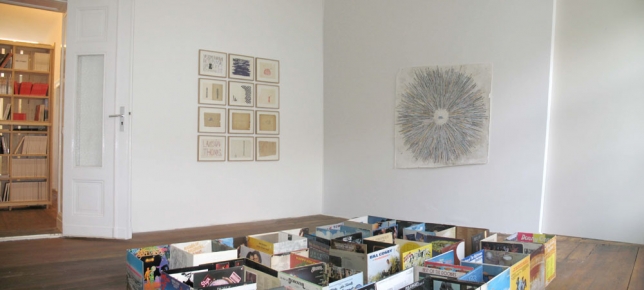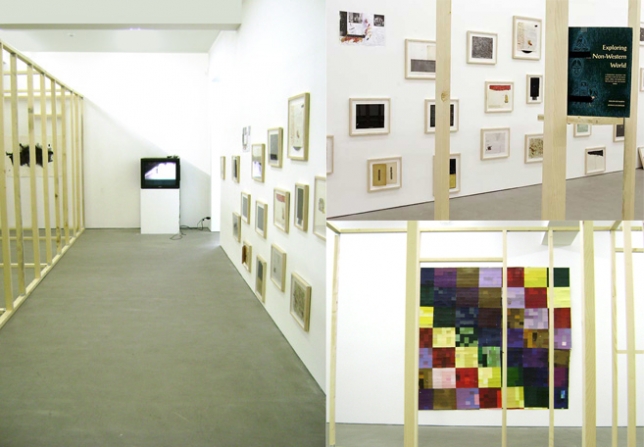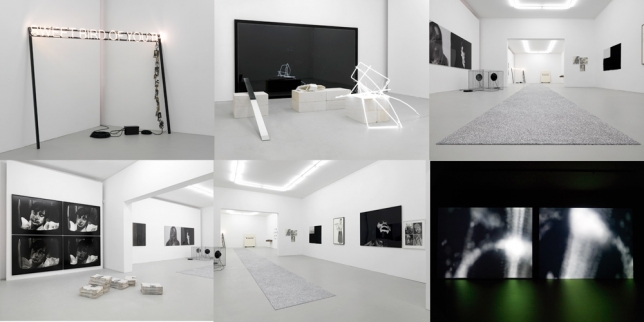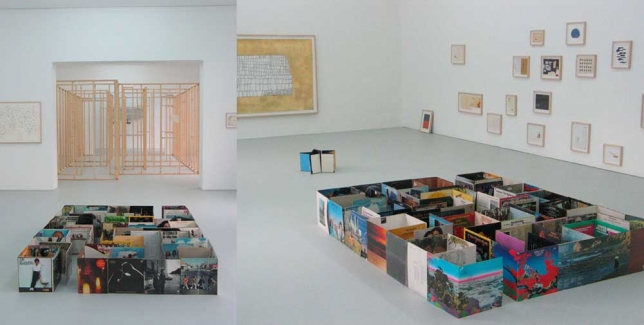30.06. – 31.08.07
"Sweet Bird of Youth" curated by Hedi Slimane
Group exhibition with works by
Slater Bradley, Mathew Cerletty, Dan Colen, Gardar Eide Einarsson, Terence Koh, Douglas Kolk, Nate Lowman, Ryan McGinley, Matt Saunders, Steven Shearer, Hedi Slimane, Paul P., Banks Violette
PRESS RELEASE
The French fashion designer and artist Hedi Slimane will show his first group exhibition curated for Arndt & Partner Berlin: "Sweet Bird of Youth".
The title "Sweet Birth of Youth" is borrowed from a play by Tennessee Williams. Upon his return to his hometown the play's protagonist, Chance Wayne, finds himself torn between two women: a has-been film diva, whose role alludes to his failed attempt at an acting career in Hollywood, and the left-behind love of his youth. His past having caught up with him, Chance desperately chases the sweet bird of youth trying to give his failed life a positive turn. "Sweet Bird of Youth" refers to this in-between state, to the insight that the world of youth cannot be retrieved once it has passed by like a sweet bird. Similar allusions are to be found in the works assembled by Hedi Slimane. The works which are for the most part created by friends of Slimane also have in common that their colour palette is limited to black and white.
The works of Douglas Kolk (born in 1963) very impressively capture this torn state described above. The drawings by the American artist, who had to cease working in 1999 due to excessive drug use, and who took up making art again only in 2004, depict shadowy faces and fragmented bodies which - devoid of meaning-seem like blasé fashion stars. Ghosts, skulls, and monstrous grimaces float about the fragile, subtle creatures and liberate them from the context of fashion statements, thus articulating in a fragmentary way their anger, yearnings, and fears.
While Kolk plays in his sometimes seemingly chaotic visual spaces with signs of youth and fashion cultures, the Canadian Steven Shearer (born in 1968) addresses the language of death metal, a specific subculture. The often unbridled description of violence in this music genre is a safety valve for anger at our society. Apart from provoking statements that Shearer finds in Internet chatrooms, he also uses photo collages and other found material like photographs, posters, and clippings from teenager magazines for his paintings. Stylistically reminiscent of Edvard Munch or Henri de Toulouse-Lautrec, his longhaired heavy metal fans exhibit a surprising vulnerability.
While Shearer succeeds in attracting attention and sympathy for his outsiders through the provoking elements of his installations and the old-master quality of his paintings, Banks Violette (born in 1973) takes up another aspect of death metal. In his expansive works, the American artist quotes the symbolism of death and decay, making the beholder shudder. In his shiny black new-Gothic sculptures, he takes up the iconography of heavy metal, both on a formal-aesthetic level as well as in terms of content. His works are inspired by true events, for example, the gruesome murder of a girl by three high-school students. Violette thematises violence so prevalent in the life world of these young people, which they use to demonstrate their distance to society.
The light and space installations of Terence Koh (born in 1977) also avail themselves of a wide spectrum of subcultural fields of association, without however being linked to concrete social groups. In his museum-quality installations he often uses banal materials that are charged into becoming fetishes through gay symbols. Far removed from any moral restrictions, his works reflect on topics like temptation, pleasure, and desire.
Similar aspects can also be found in the painting of the American artist Paul P. (born in 1977), who is influenced both by classical portrait painting and by gay pornography of the late 1970s and early 1980s. Young men in lascivious poses populate his works; sensitively portrayed and apparently in communication with the beholder, their originally pornographic background disappears. The works retain a certain "memento mori" effect, because these men are porn actors from the beginning of the era of AIDS.
Mathew Cerletty's portraits of himself or of family members reveal an exhibitionist pleasure. The beholder encounters figures in everyday situations, executed in a masterly style, who are often imbedded in flowery or abstract patterns, staring into space or apparently waiting for something. These opulent paintings stand alongside formalistic works that focus on language. In "Sweet Bird of Youth", Cerletty is presenting the drawing "The Feeling is Mutual". The white writing on a black background reads like an anti-message, but refrains from any explanation.
An engagement with representative systems used by the mass media or to designate subcultural difference is also central to the work of Gardar Eide Einarsson (born 1976). Known for his social architectures and artistic experiments with skaters, American youth gangs and drug addicts, the Norwegian artist uses a heterogeneous array of media such as painting, video and sculpture to investigate the communicative strategies of subgroups and their quest to find and assert their own identity.
The Norwegian artist's fascination with subcultural groups is shared by New York photographer Ryan McGinley (born 1977), whose motifs often depict friends, lovers, skateboarders, graffiti artists and kids at a loose end. With a documentary sensitivity and an uncompromising verité style, McGinley shows us the light and dark sides of the rites of passage into adulthood by capturing his subjects in public at parties and concerts, as well as in moments of absolute intimacy. In doing so, the artist offers a very personal take on the life of this generation.
Mass media, subculture and an investigation of the passage into adulthood are also fundamental to the work of American artist Dan Colen (born 1979). His painted sculptures transform everyday subcultural artifacts into high art monuments to the lives of "twentysomethings" and downtown socialisation. In meticulously painted text works and sculptures that conversely evoke the spontaneity of graffiti, his works mine our need to establish an individual identity and the perpetual efforts the self undertakes to construct and affirm this identity.
The oil paintings, drawings and animations of Matt Saunders (born 1975) also investigate the construction of identity in a media saturated era in which individuals seem more likely to play a role than actually live their lives. His interest lies in the moments in which his protagonists slip out of character, or in which film icons step out of their roles to expose the everyday life of the person behind the public persona.
Known for his "Bullet-Hole" silkscreen paintings, the work of Nate Lowman (born 1979 in Las Vegas) is charged by a punkrock aesthetic mixed with a strong political load. His critical distance to the culture, society and art scene of America is characteristic of the young generation of artists represented in "Sweet Bird of Youth". The iconography of this generation is remarkable for its sometimes subtle, sometimes loud mixture of madness, rebellion, politics and violence.
